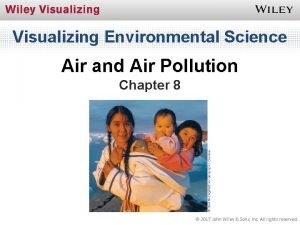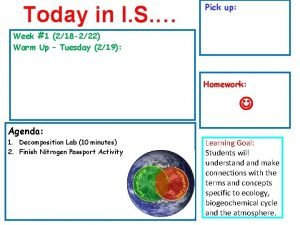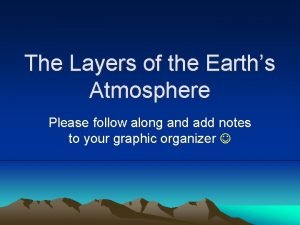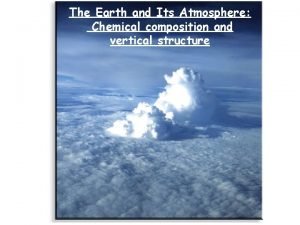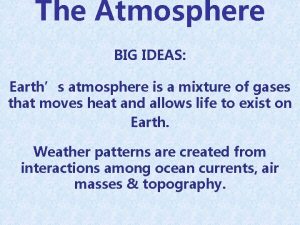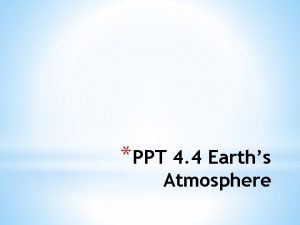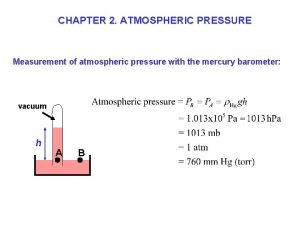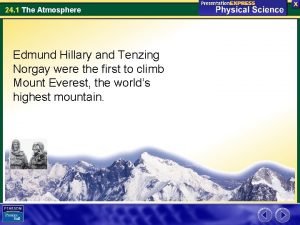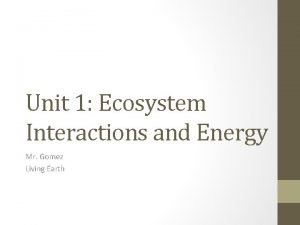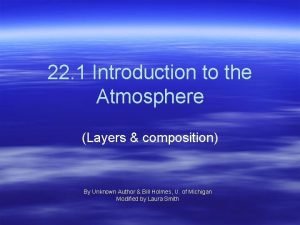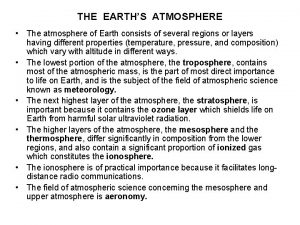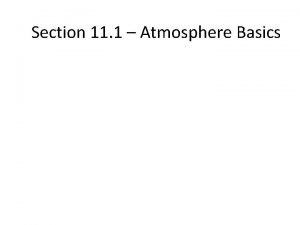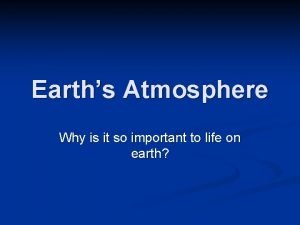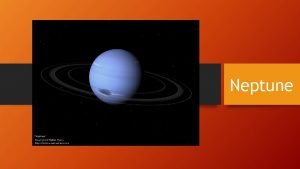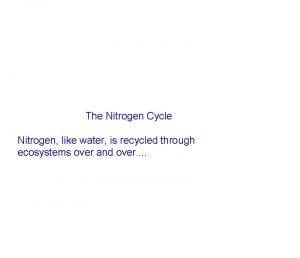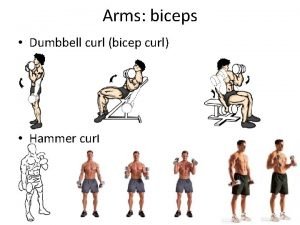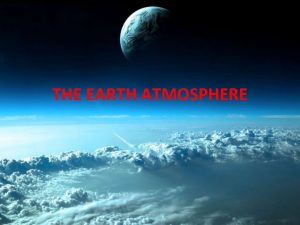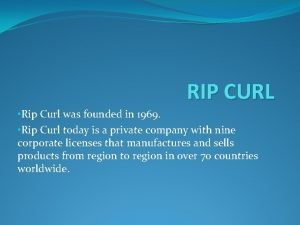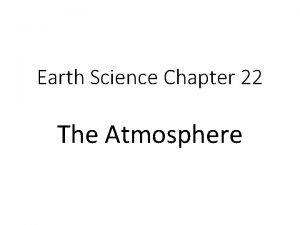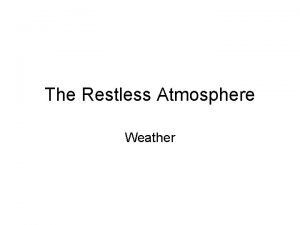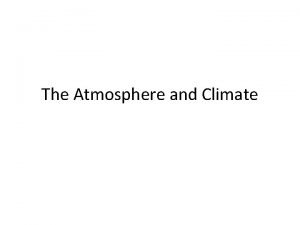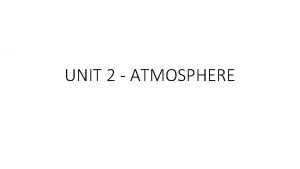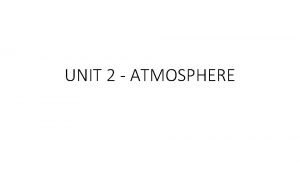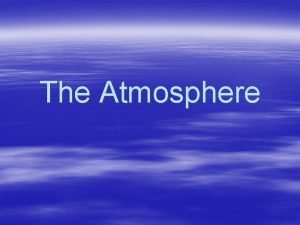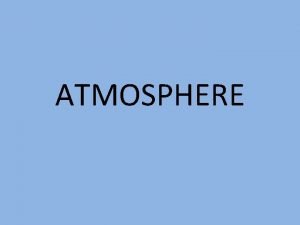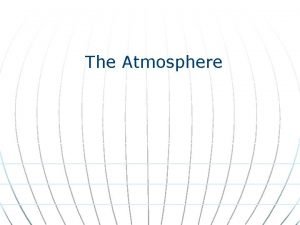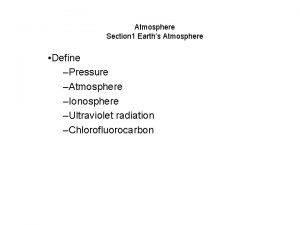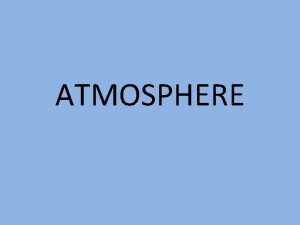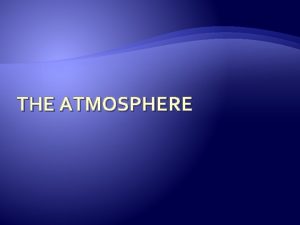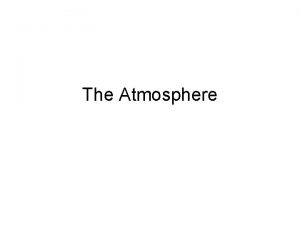Atmosphere Earth Science Mr Curl WHAT DOES THE























- Slides: 23

Atmosphere Earth Science Mr. Curl

WHAT DOES THE ATMOSPHERE DO? BREATHING COMES NATURALLY We need oxygen to keep our bodies working. Just try holding your breath for a few seconds and see what happens. People are not the only ones who need oxygen; all kinds of animals need it too. Without the atmosphere we would all quickly die A RADIATION SHIELD The atmosphere of Earth protects us and all living things on the earth from dangerous radiation from the sun. In addition to the light we see, the sun also gives off ultraviolet radiation. Much of it is filtered out by the atmosphere.

SECURITY BLANKET The atmosphere also keeps us warm. It holds the surface heat on the earth and prevents it from radiating out into space. We call this the greenhouse effect. WEATHERING THE STORMS Without the atmosphere, the water could not reach the farmer's fields to grow our food. Very complex weather patterns including trade-winds and jet streams are part of the atmospheric circulation of the air that distributes heat around the earth. Weather is a function of our atmosphere. LOOK OUT BELOW! Another really important thing that the atmosphere does is to protect us from objects coming toward the earth from outer space. Every day meteroids enter the Earth's atmosphere. These are pieces of rock that are traveling through space. When they reach the atmosphere, most of them burn up due to the friction of the air.

PLANT LIFE Plants use the carbon dioxide (CO 2) along with sunshine to carry out a process called photosynthesis. In this process the plants convert the sunlight, carbon dioxide, and nutrients from the ground into energy for them to grow and oxygen for us to breathe. GETTING OFF THE GROUND Many plants also depend on insects and birds to carry their pollen and their seeds to make it possible for them to reproduce. Birds and insects could not fly without the air to support them. LET'S TALK If you were talking to your friend and there were no air between the two of you, your friend would not be able to hear a thing you said. Sound waves depend on the air to carry them from one person to another.

Solar Energy as Radiation Figure 1. 1 Nearly 150 million kilometers separate the sun and earth, yet solar radiation drives earth's weather.

Earth's Atmosphere Thin Gaseous envelope Figure 1. 2 The atmosphere is a thin layer of air that protects the Earth’s surface from extreme temperatures and harmful sun rays

Composition of Atmosphere (Mixture of gases, solids, and liquids) • Origin – the early atmosphere was much different than today • Volcanoes produced nitrogen and carbon dioxide, but little oxygen • More than 2 billion years ago, early bacterial organisms (stromatolites) began producing oxygen through a process similar to photosynthesis. • Eventually, oxygen formed an ozone layer that protected Earth from harmful rays • Green plants and diverse life forms developed Video Origin

Atmospheric Gases (Mixture of gases, solids, and liquids) • Nitrogen - 78% • Oxygen - 21% • Water Vapor – 0 to 4% • Used for clouds and precipitation • Carbon Dioxide -. 037% • Keeps Earth warm and is used by plants to make food • Argon -. 93% • Traces of neon, helium, methane, krypton, xenon, hydrogen, and ozone

Atmospheric Gases (Mixture of gases, solids, and liquids) • Atmosphere is changing with the introduction of pollutants; increasing human energy use is increasing the amount of carbon dioxide • Pollutants mix with oxygen and other chemicals to form smog • Aerosols include solids such as dust, salt, and pollen • Liquids include water droplets and droplets from volcanoes

Questions True or False? 1. The Atmosphere has always been the same as it is now. False, the early atmosphere contained different combinations of gases! 2. Little bacteria produced most the of the present day atmospheric oxygen. True, stomatolites (cyanobacteria) underwent photosynthesis 3. Carbon dioxide is more abundant in our atmosphere than water vapor and that is why the Earth is warming. False, CO 2 = 0. 04% water vapor is more abundant and traps more heat than carbon dioxide.

Four Layers of the Atmosphere

Lower Layers of Atmosphere • Troposphere: lowest layer – extends up to 10 km; contains 99% of the water vapor and 75% of the atmospheric gases • The troposphere is the first layer above the surface and contains most clouds and half of the Earth's atmosphere. • Weather occurs in this layer. • Most of the layer’s heat is from Earth • Temperature cools about 6. 5 degrees Celsius per kilometer of altitude.

Lower Layers of Atmosphere • Stratosphere – directly above troposphere, extending from 10 km to about 50 km above Earth’s surface • Portion of the upper layer contains high levels of a gas called ozone • Many jet aircrafts fly in the stratosphere because it is very stable. Also, the ozone layer absorbs harmful rays from the Sun.

The Ozone Layer • About 19 km to 48 km above Earth in the stratosphere (90%) and troposphere (10%). • Layer of 3 -atom molecules that protects the Earth from the Sun’s harmful ultraviolet radiation • Life depends on the ozone! • Pollutants called chlorofluorocarbons (CFCs) are destroying the ozone • CFCs are used in refrigerators, air conditioners, aerosol sprays, and foam packaging ~ if products leak, then CFCs enter atmosphere • Ozone layer has a large hole over Antarctica and a smaller one over the North Pole




Questions Continued. . . 4. How is ozone made in the atmosphere? The sun makes the ozone from oxygen molecules and atoms. 5. How does chlorine destroy ozone? Chlorine steals one of the atoms from the O 3 molecule. 6. What would happen if the ozone layer went away? The sun’s radiation would burn-up all the surface life forms.

Upper Layers of Atmosphere • Mesosphere – extends from the top of the stratosphere to about 85 km above Earth • Coldest layer with little ozone • Meteors or rock fragments burn up in the mesosphere. • Ionosphere – layer of charged particles

Upper Layers of Atmosphere • Thermosphere – largest (by volume) atmospheric layer is found between 85 km and 500 km above Earth’s surface • The thermosphere is a layer with auroras, known for its high temperatures. • Warms as it filters out X-rays and gamma rays from the Sun • Ionosphere, too – help carry radio waves.

Upper Layers of Atmosphere • Exosphere - The atmosphere merges into space in the extremely thin exosphere. This is the upper limit of our atmosphere. • Outer layer where space shuttle orbits.

Layers of Atmosphere Video

 The atmosphere protects earth from
The atmosphere protects earth from What is the earth's atmosphere made of
What is the earth's atmosphere made of Thermosphere
Thermosphere Earth's atmosphere composition
Earth's atmosphere composition Explain composition and structure of atmosphere
Explain composition and structure of atmosphere Earth atmosphere ppt
Earth atmosphere ppt Earth atmosphere radius
Earth atmosphere radius The atmosphere protects earth from
The atmosphere protects earth from Describing earth's atmosphere lesson 1 answer key
Describing earth's atmosphere lesson 1 answer key Earth's atmosphere
Earth's atmosphere Atmosphere layers definition
Atmosphere layers definition Earth surface atmosphere
Earth surface atmosphere Earth’s atmosphere
Earth’s atmosphere Gases on earth's atmosphere
Gases on earth's atmosphere Atmosphere layer
Atmosphere layer Kleinhans kehl
Kleinhans kehl What was your favorite subject as a child
What was your favorite subject as a child What type of atmosphere does neptune have
What type of atmosphere does neptune have Tank cycling
Tank cycling Hình ảnh bộ gõ cơ thể búng tay
Hình ảnh bộ gõ cơ thể búng tay Lp html
Lp html Bổ thể
Bổ thể Tỉ lệ cơ thể trẻ em
Tỉ lệ cơ thể trẻ em Gấu đi như thế nào
Gấu đi như thế nào
